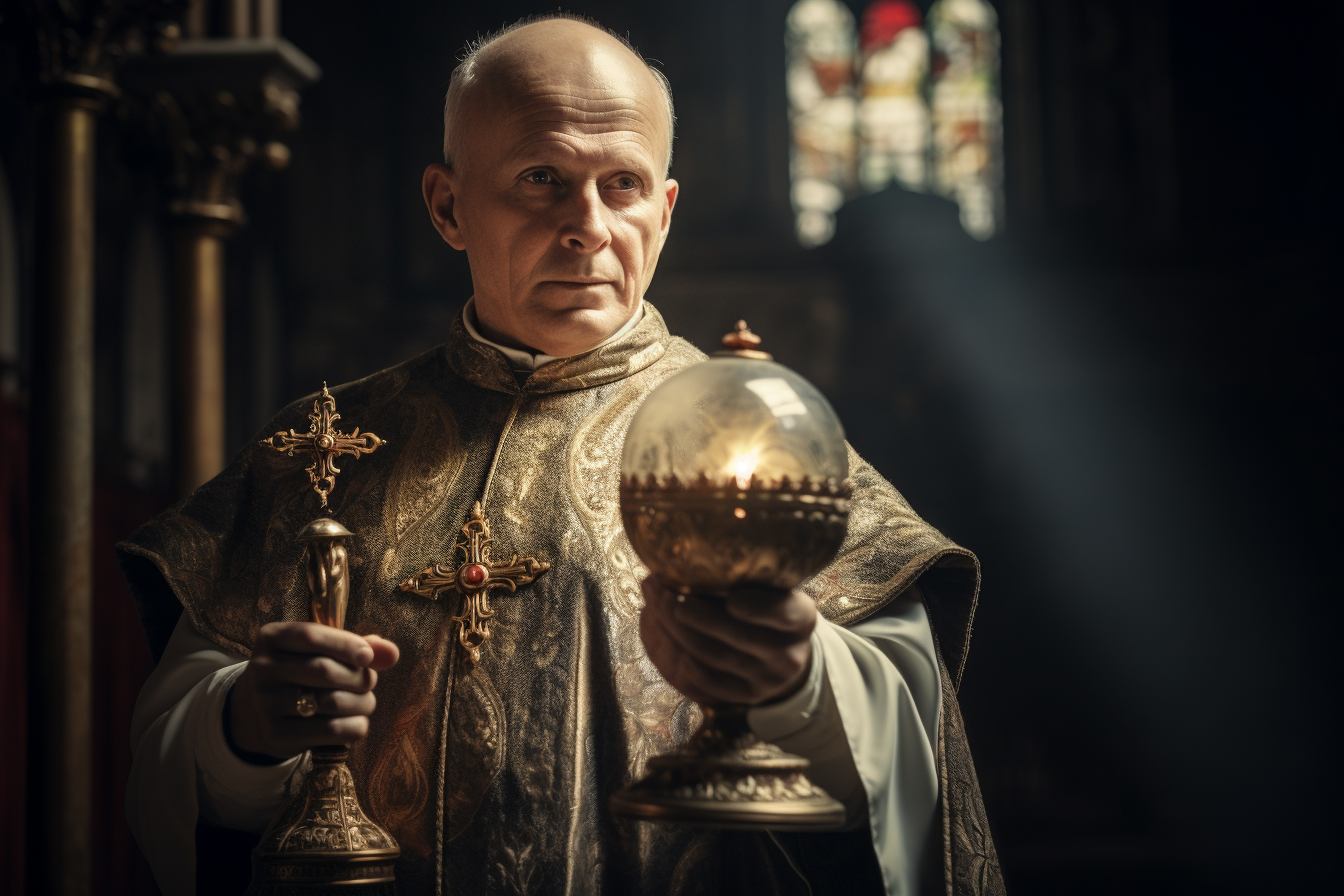
St. Norbert
Saint Norbert
- When he lived: St. Norbert was born around the year 1080 and died on June 6, 1134.
- Where he lived: St. Norbert was born in Xanten, a town located in the present-day region of North Rhine-Westphalia, Germany. He traveled extensively during his lifetime, including to France, and founded the Premonstratensian order (also known as the Norbertines) in Premontre, France.
- Notable world events during the time of his life:
- The Investiture Controversy was a significant conflict between church and state in medieval Europe that began in the late 11th century and continued during St. Norbert’s lifetime.
- The First Crusade occurred from 1096 to 1099, resulting in the establishment of the Kingdom of Jerusalem.
- The Concordat of Worms, resolving the Investiture Controversy to a large degree, occurred in 1122, towards the end of St. Norbert’s life.
- The Growth of Towns and Trade: The 11th and 12th centuries saw the beginning of significant growth in towns and long-distance trade in Europe. This was the early phase of the Commercial Revolution of the Middle Ages.
- Scientific Advances in the Islamic World: During this period, scientists in the Islamic world were making significant advances, particularly in fields like medicine, mathematics, and astronomy. The works of scholars like Avicenna and Averroes were particularly influential.
- The Compilation of the Domesday Book: Commissioned by William the Conqueror, this great survey of England was completed in 1086. It’s one of the most significant historical records from the Middle Ages.
- The Founding of the University of Bologna: Around 1088, the University of Bologna in Italy was founded, making it one of the oldest universities in the world. This period was one of increasing intellectual activity, with new universities being founded and ancient texts being rediscovered and studied.
- His patronage: St. Norbert is the patron saint of Bohemia. He is also invoked for safe childbirth and is considered a patron of pregnant women and unborn children due to a miracle attributed to him where he revived a mother and her newborn child, both of whom had died during childbirth.
St. Norbert, a revered saint born in the 11th century, walked a path that began far from the sanctity we often associate with him. His early life in Xanten, Germany, was one of nobility, luxury, and courtly pleasures, reflecting our own human inclination towards enjoyment and comfort.
But just as many of us experience, it was a moment of profound suffering and upheaval that became transformative for Norbert. In these challenging moments, we often find our lives taking unexpected turns, and it is precisely in these times of pain that God often calls us closer to Him.
In Norbert’s life, this moment was no different. A violent thunderstorm and a brush with death forced him to confront his existence and the path he had been walking. This moment, fraught with fear and uncertainty, became the pivot on which his life turned towards a deeper spiritual calling.
As we delve deeper into St. Norbert’s life, we’ll find threads of commonality in our human journey. By highlighting the shared experiences of transformation and divine calling in the midst of suffering, we can relate more intimately to the saintly journey of St. Norbert.
The Early Life of St. Norbert
St. Norbert was born into a noble family in Xanten, Germany, around 1080, and his early years were steeped in the ways of the world. A life marked by privilege and comfort, filled with worldly pleasures such as music, horseback riding, and the companionship of fellow courtiers, was the norm for him.
Norbert, much like many of us, was entwined with the allure of worldly delights. His days were carefree, a testament to the joys and attractions the world presents us. The relatability of this phase of Norbert’s life lies in our own journey, as we all, at some point, are captivated by the world’s offerings.
However, the worldly path Norbert was following was soon to be challenged. A significant event was on the horizon, one that would shake his worldview and compel him to consider the ways of faith over the ways of the world.
Transformative Experience
A life-changing moment came upon St. Norbert one fateful day when he encountered a violent thunderstorm. As he was riding his horse, a lightning bolt struck alarmingly close to him, flinging him to the ground. In this harrowing instance, Norbert came face-to-face with his own mortality.
This near-death experience ignited a profound spiritual crisis within him. Until this point, Norbert had lived a life defined by worldly pursuits and pleasures, untouched by the profound questions of existence and purpose. Now, lying on the ground and shaken to his core, he found himself suddenly confronted with these deeper queries.
His brush with death brought a new awareness of the fragility and transience of life. It starkly highlighted the ephemeral nature of the worldly delights he had so ardently pursued. This confrontation with life’s fleetingness raised crucial questions: Was his life on the right path? Was there more to existence than the pleasures and comforts of the world?
This profound crisis of faith is not unfamiliar to many of us. Often, it’s in moments of suffering, fear, or deep introspection that we begin to question the meaning and purpose of our lives. These moments of reckoning force us to reassess our paths and the values we hold dear.
Amid this turmoil, Norbert felt an overwhelming divine call. It seemed that God was reaching out to him in his moment of suffering, inviting him to seek solace and purpose not in the worldly pleasures he had known but in a life dedicated to faith. This transformative experience became a watershed moment in Norbert’s life, forever altering his path and marking the onset of his journey towards sainthood.
Norbert’s Change of Path
Following his profound encounter with mortality during the thunderstorm, Norbert was stirred into action. He resolved to relinquish the worldly life he had previously led. This was not a decision taken on a whim but rather a deeply considered choice, birthed from introspection and the call he felt towards a divine path.
Norbert chose to adopt asceticism, bidding farewell to his wealth and the luxuries he had once enjoyed. He opted for a life of poverty, an explicit symbol of his new-found dedication to the spiritual path. This transition from the grandeur of worldly pleasures to the humility of spiritual simplicity marked a significant turn in his life.
His commitment to this new path led him to pursue ordination as a priest. This was not just about personal transformation; Norbert was intent on dedicating his life to the service of God and the wider community. The decision was a testament to his conviction and the depth of the change within him.
The journey of Norbert stands as an enduring testament to the transformative power of personal crises. His decisions reflect the potential that such moments of reckoning hold to catalyze significant shifts in one’s life path and priorities.
Founding of the Premonstratensian Order
Galvanized by his deep faith and sense of purpose, Norbert established a new religious order known as the Premonstratensians, or Norbertines. This was more than just a group of like-minded individuals; it was a community deeply rooted in the ideals that Norbert had come to embody: poverty, chastity, and obedience.
The Norbertines’ charism, or spiritual focus, was unique, reflecting Norbert’s own spiritual journey and values. The order was characterized by a commitment to both contemplative life and active ministry. This dual focus allowed them to cultivate their own spiritual lives while also serving the wider community.
While many religious orders were either wholly contemplative or wholly active, the Norbertines held these two facets in balance. This was a reflection of Norbert’s personal transformation—a journey from worldly indulgence to spiritual commitment, from self-centeredness to service.
However, the formation of the Premonstratensian Order was not a straightforward endeavor. Norbert faced considerable opposition and challenges along the way. Despite this, he remained resilient and unwavering in his vision, echoing the same determination he had shown when he decided to change his own path.
Over time, his perseverance bore fruit, and the Norbertine Order flourished. The resilience and commitment that Norbert demonstrated in the face of resistance serve as an enduring testament to his dedication to the path of faith and service.
Elevated to Bishop
Norbert’s influence and dedication did not go unnoticed, and he was appointed Archbishop of Magdeburg. In this new role, he continued to uphold the principles that had guided his own transformation, focusing on both spiritual cultivation and active service.

As Archbishop, Norbert faced numerous challenges. His dedication to reform and adherence to his principles often led to conflicts with others. Yet these conflicts did not deter him. Instead, they underscored his unwavering commitment to the path he had chosen.
He continued to live according to the ideals of the Norbertine Order, maintaining a simple lifestyle even while holding an influential position. This was a reflection of his personal commitment to the principles of poverty and simplicity that had guided his transformation.
Norbert’s later life was marked by a deep dedication to the principles he had embraced. He passed away on June 6, 1134, leaving behind a legacy of profound faith, unwavering commitment to his principles, and dedicated service to his community.
His life, characterized by remarkable transformation and steadfast dedication, offers us a glimpse into the journey of a man who chose the path of faith over worldly pleasures. It serves as a reminder of the transformative power of personal crises and the impact such transformations can have on the wider community.



